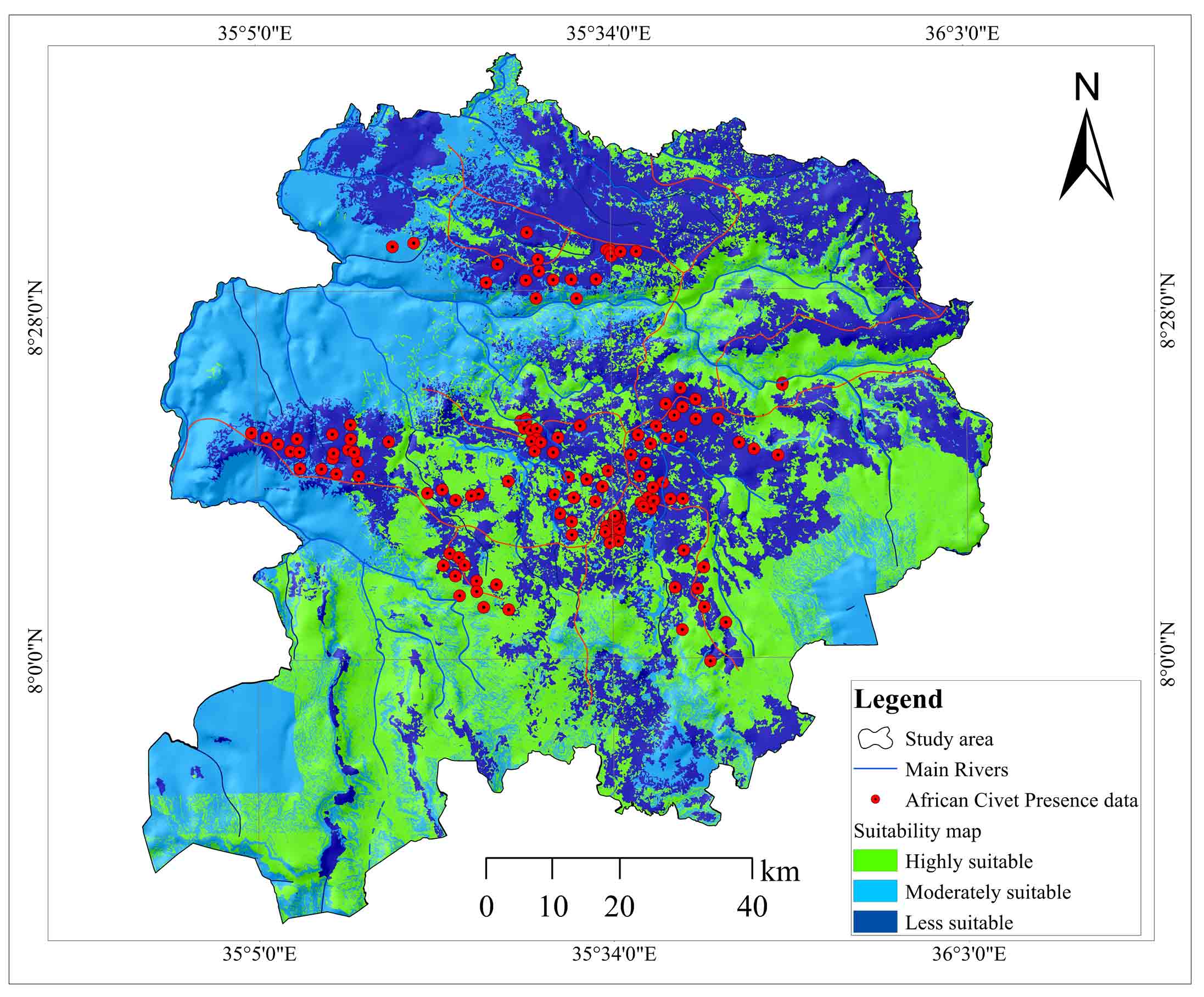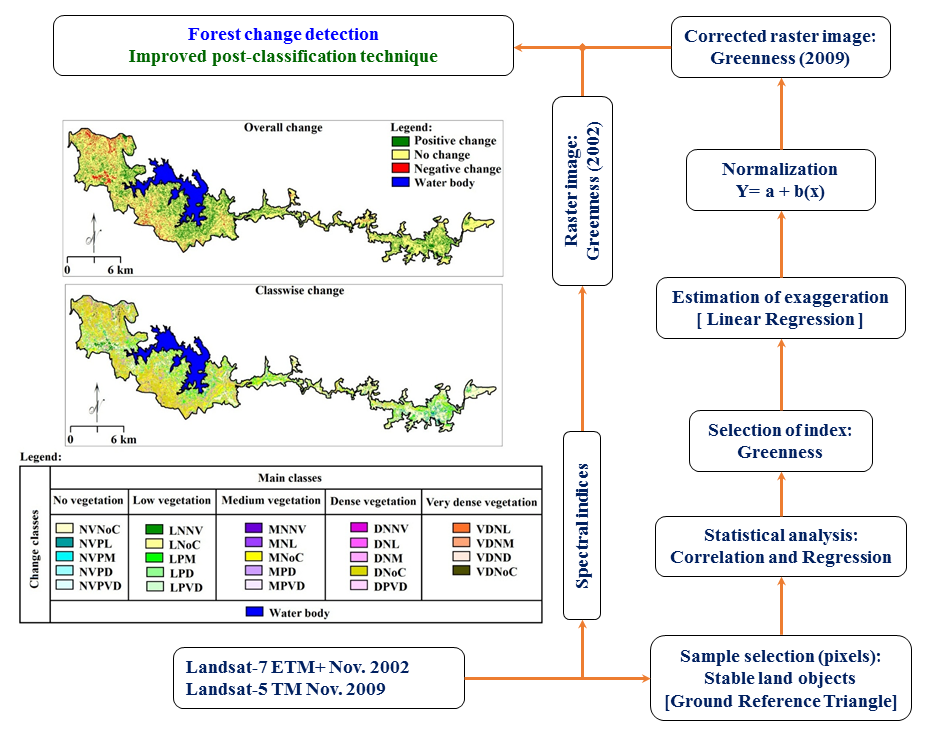Article Title :
African Civet Habitat Mapping in Illu-Abbabora Zone, Southwest Ethiopia: Geospatial Approach
5 (2021)
1-13
African Civet , Change Detection , GIS , Habitat suitability , Landsat , Land Use / Land Cover


The African Civet (Civettictis Civetta Shreber, 1778) is one of the important natural animal resources of Ethiopia. Ethiopia is the major producer of the Civet perineal gland secretion (known as “civet”) used extensively as a base in perfume industry. However, there is no improvement in civet farming processes in rural Ethiopia, and the farmers still live in a poor state. Majority of rural population in Ethiopia is depending on agriculture, and hence land-use changes during the past couple of decades are mostly linked to agricultural development. Present study was undertaken to predict the spatial distribution of land-use and land-cover and habitats of the African Civet here in after referred as civet(s) in Illu-Abbabora Zone, Southwest Ethiopia. Landsat images of three years: 1985, 2000 and 2018 were classified to generate land-use/land-cover maps, locate forests and other land classes. Results of the study revealed that forest and wetland habitats decreased by an estimated 11.12 km2/yr-1 and 2.39 km2/yr-1, respectively during the period of 1985-2018. In contrast, the extent of agricultural land, urban area and Gumro tea plantation increased by an estimated 13.36 km2/yr-1, 0.59 km2/yr-1 and 0.43 km2/yr-1, respectively. Habitat suitability approach was found to have great potential in predicting potential habitats of the civets through complex non-linear models.

African Civet habitat mapping is important for local formers in Ethiopia.
Suitability analysis is a GIS-based multi-criteria decision making process.
We integrate GIS and AHP technique for African Civet habitat suitability analysis.
The outcome of this research shows that the Civet presence areas in Illubabor Zone, Southwest Ethiopia.
Abebe, Y., 2003. Sustainable utilization of the African civet (Civettictis civetta) in Ethiopia. In: The Second Pan-African Symposium on the Sustainable Use of Natural Resources in Africa, IUCN, Gland, 197-208.
Ayele, K. F., Suryabhagavan, K. V. and Sathishkumar, B., 2014. Assessment of habitat changes in Holeta Watershed, Central Oromiya, Ethiopia. International Journal of Earth Sciences and Engineering. 7, 1370-1375.
Ayele, K. F., Suryabhagavan, K. V. and Sathishkumar, B., 2014. Assessment of habitat changes in Holeta Watershed, Central Oromiya, Ethiopia. International Journal of Earth Sciences and Engineering. 7, 1370-1375.
Berwick, H. S. and Saharia, B.V., 1995. The Development of International Principles and Practice of Wildlife Research Management; Asian and American Approach. Oxford University Press, Delhi.
FAO [Food and Agriculture Organization], 2000. World Watch List for Domestic Animal Diversity. D. S. Beate 3rd Ed. FAO, Rome, Italy. 702-703.
Gwet, K., 2002. Kappa statistic is not satisfactory for assessing the extent of agreement between raters. Stat. Methods Inter-Rater Reliab. Assess. 76, 378-382.
Kafley, H., 2008. Habitat evaluation and suitability modeling of rhinoceros unicornis in Chitwan National Park, Nepal: A Geospatial Approach, Institute of International Education, World Wildlife Fund, Buenos Aires.
Kumera, W., 2005. Improving civet cat farming for quality musk production (Amharic version). Agriculture and Rural Development Bulletin, 6, 31-34.
Kushwaha, S. P. S., Munkhtuya, S. and Roy, P. S., 2001. Mountain goat habitat evaluation in Rajaji National Park using remote sensing and GIS. J. Ind. Soc. RS. 28, 293-303.
Kushwaha, S. P., Roy, P. S., Azeem, A., Boruah, P. and Lahan, P., 2000. Land area change and habitat suitability analysis in Kaziranga. Tiger. Pap. 27, 9-17.
Melakneh, G., Suryabhagavan, K.V. and Balakrishnan, M., 2010. Land-use and landscape pattern changes in Holeta-Berga Watershed, Ethiopia. Int J Ecol Environ Sci. 36,117-132.
Mesfin Admasu., 1995. History of civet farming and trade in Ethiopia. In: Civet Farming, Musk Production and Trade Workshop, Ethiopian Wildlife Conservation Organization, Addis Ababa. 72-78.
Misrak, A., Suryabhagavan, K. V. and Balakrishnan, M., 2012. Assessment of cover change in the Harenna Habitats in Bale Mountains, Ethiopia, using GIS and remote sensing. Int J Ecol Environ Sci. 38, 39-45.
Pugh, M., 1998. Civet Farming: An Ethiopian Investigation. World Society for the Protection of Animals, London.
Saaty, T. L., 1993. The analytic hierarchy process: A overview. Central European Journal of Operation Research and Economics, 2 (2), 119-137.
Smith, R. L., 1974. Ecology and Field Biology, Harper and Row, New York.
Strahler, A. H., Boschetti, L., Foody, G. M., Friedl, M. A., Hansen, M. C., Herold, M., Mayaux, P., Morisette, J. T., Stehman, S. V. and Woodcock, C. E., 2006. Global Land Cover Validation: Recommendations for Evaluation and Accuracy Assessment of Global Land Cover Maps 48 Technical Report, Joint Research Centre, Ispra, EUR 22156 EN.
Zarri, A. A., Rahmani, A. R., Singh, A. and Khushwaha, S. P. S., 2008. Habitat suitability assessment for the endangered Nilgiri Laughing Thrush: A multiple logistic regression approach. Current Science, 94, 1487-1494.
Zarri, A. A., Rahmani, A. R., Singh, A. and Khushwaha, S. P. S., 2008. Habitat suitability assessment for the endangered Nilgiri Laughing Thrush: A multiple logistic regression approach. Current Science, 94, 1487-1494.




